
GT750E
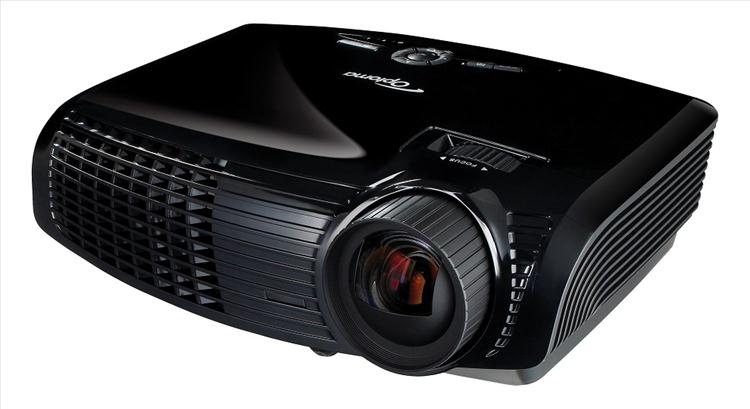
The Specs
| Model | GT750E |
|---|---|
| MSRP | $749 |
| Best Retail price | $704 |
| Engine Type | DLP 120Hz |
| Native Resolution | 1280 x 800 |
| Contrast | 3000:1 |
| Speakers | Stereo 10-Watt Speakers |
| Lamp Life (Hrs) | 4000/3000 Hours (STD/Bright) |
| Dimensions (In) | 12.76” x 3.82” x 9.21” |
| Weight (lbs) | 6.6 lbs |
| Warranty | 1 Year Limited Parts and Labor, 90 Days on Lamp |
| Inputs | HDMI (2), VGA, S-Video, Composite, Stereo RCA Audio and RS-232 |
| Outputs | Stereo Audio |
| ANSI Lumens | 3000 |
| Screen Size (in) | 32.2” to 322.4” |
| Throw Distance (ft) | 1.64’ to 16.4’ |
Out of the Box
The Optoma HD750E is packaged much like the last few Optoma projectors we have reviewed in a vertical box with carry handle and as well protected as you could ever want. The HD750E is shipped with multiple layers of protection, including the box, a rigid air-shell, a soft-foam bag and a film to protect the finish. As an extra layer, the air-shell is packed within the included Optoma Game Time backpack to take your projector on the go. In addition to the backpack, the box also contains a power cord, VGA to Component Adapter, Remote Control, Batteries for Remote, Lens Cap, CD-ROM User's Manual, Quick tart Card, Multilingual Warranty Card and an RF Emitter for the 3D glasses (glasses themselves not included.)
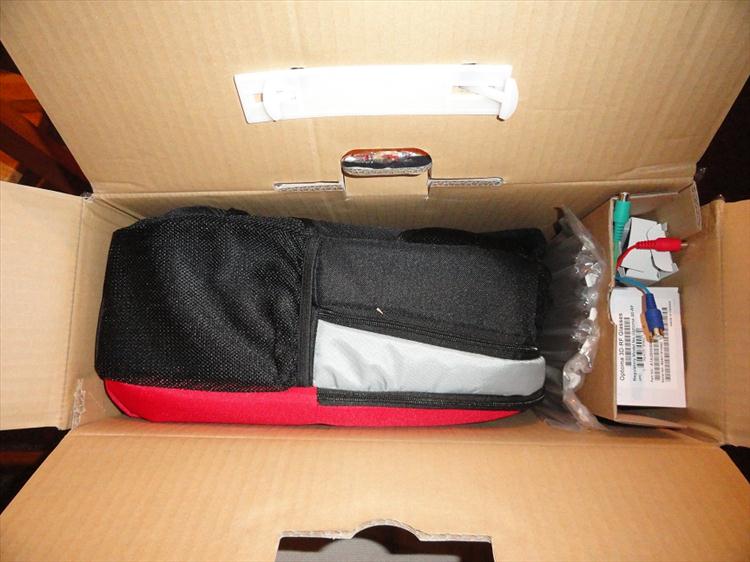
Aesthetics
The Optoma HD750E looks almost identical to the design of the HD720, with the chassis having many of the same characteristics including a gorgeous high-gloss black finish. Both side panels and the half of the front panel sports fins that conceal vents, to keep the projector extremely cool. Also on the front is the lens, which has an attached rubber lens cap to keep it covered during non-use. The top has all of the controls, including focus, power, menu, indicator lights and all other controls you would need to navigate the on-screen menu.
The back panel of the HD750 is laid out smartly for any type of installation with plenty of space between all of the ports. The video outputs (two 1.4a HDMI, VGA, S-Video, VESA3D and Composite video ports) are all on the same row, while the audio ports are below in their own grouping. The other connections are the RS232 and power connection as well as a Kensington Lock. One item of note is that Optoma does supply an adapter for the VGA port that will convert it to accept Component video inputs.
Overall, the HD750 sports a compact and clean design, which allows it to blend into a dedicated home theater room as easily as it can become a mobile gaming platform. Anyway you wish to use it; the HD750 should be able to easily accommodate your choice.
Remote
Despite Optoma blending the GT720 and HD33 into the creation of the GT750E, they decided to stick with the GT720 remote, which is a little on the bland side. Don’t get me wrong, it does what it needs to do, but the remote of the HD33 has much more clearly defined buttons and uses. It works and I am not complaining too much, but using a different remote would have been a better solution in my opinion.
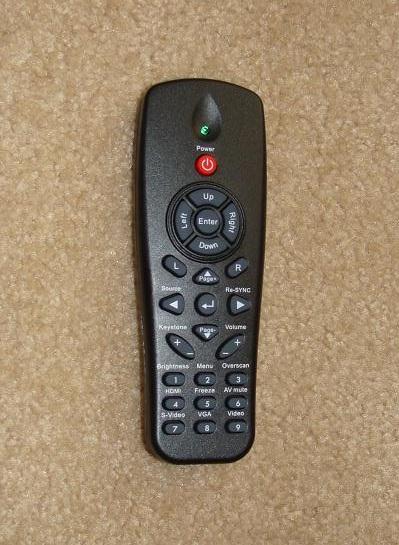
Setup
Pulling the Optoma GT750E from the box, I had a flashback to the GT720 and how quickly and easily it set up. Having set up a few Optoma projectors in the past, I was completely online required plugging in two HDMI cables and power, which had me up and running in about two minutes. With this projector being 3D, I did take a couple extra steps (such as hooking up the RF emitter for the 3D glasses and turning off the internal speaker) and make some minor adjustments to the picture settings once I had power and video flowing to get the settings where I wanted them. As with the HD33 and GT720, the focus is a manual knob, which allows you a little bit of extra control versus a motorized system and can fine tune your picture even more.
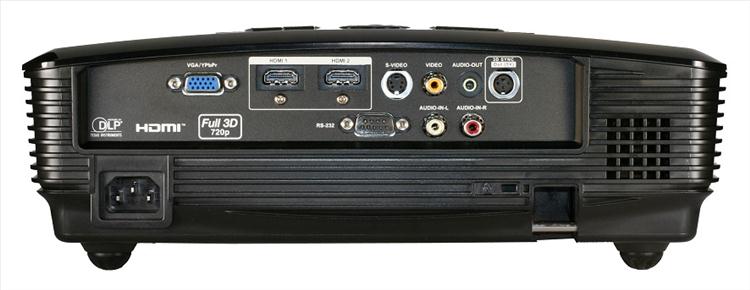
As for mounting, I again went with a table-top location, approximately six feet from the screen at a height of three and a half feet. This gave me quick access to the projector and also helped me get gaming very quickly. If you are normally intimidated about hooking up electronics, the GT750E will make you life very easy and a novice should have themselves up and running within 10 minutes or less.
Here are a couple of notes that have not changed from the GT720 to the GT750E when it comes to installation:
- The lens cap is the same large rubber piece that takes a little force to put back onto the projector
- The native 1280 x 800 resolution will not vertically fill a 16:9 screen horizontally. It’s not a large gap, but something to keep in mind...
- The GT750E supports 1080p via HDMI, but converts everything back to native 720p
Glasses
One nice thing that Optoma has done is standardize their active-shutter 3D glasses with their 3D projectors, so the same glasses that worked with the HD33 also work with the GT750E. As I mentioned when I reviewed the HD33, I think Optoma has hit on the perfect blend of comfort, quality and duration with these glasses. I stated before that the RF Technology and comfort set these apart from other active-shutter glasses, and nothing has come across that has changed my mind yet. Here are some excerpts on the glasses from the Optoma HD33 review which still holds true:
To keep costs down and use the RF technology, Optoma uses a little RF dongle that attaches to the projector that the glasses will automatically connect to. Up to four pairs of the BG-3DRFGLASSES can be connected at once to allow for a full group of movie watchers of gamers. The batteries can handle approximately 1,000 charges and they have and auto-shutoff feature after five minutes of inactivity.
As with any active-shutter 3D TV or projector, you do have to buy the glasses that match the unit. Additional pairs of glasses are not cheap, but they can be picked up through Optoma or various online retailers for around $100 a pair. Considering that the projector is at or below $1,500, another $300 investment isn’t too bad to get you and three of your friends or family into the full 3D experience.
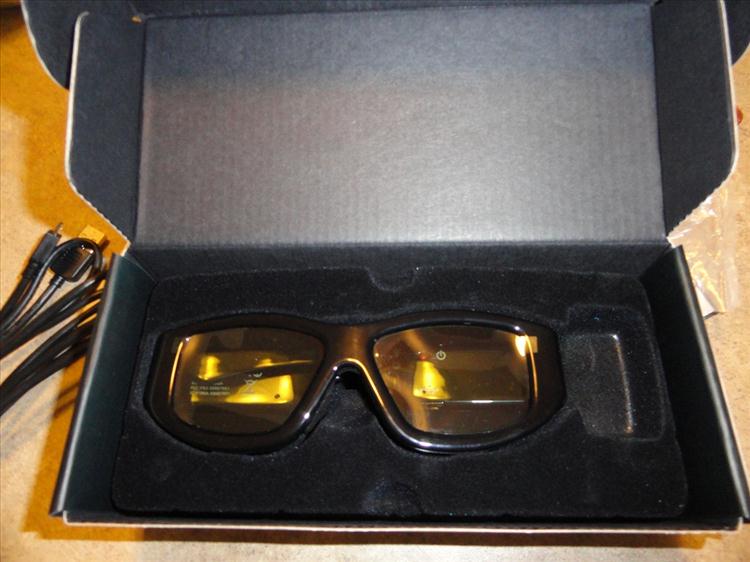
As to the charging time I mentioned above, these glasses can really hold a charge for a long time when they are not being used. They will give you every minute of the listed 70 hours of use and then some. You do need to purchase the glasses separate, but they are well worth the $75 average cost you can find them for in the internet.
Video Performance
As always, the primary function of a projector is to deliver crisp, clear and quality video, regardless of the source. For the GT750E, Netflix, ESPN3, Blu-Ray and Hulu+ were my video sources of choice for testing purposes. Having said that, I played through a while host of video sources to get a gauge on what the GT750E could or couldn’t do well. In short, I came back with two answers; it could do everything and I didn’t find anything it couldn’t do. I know that may seem like a bit of a cop out, but with 20+ hours of video testing, I was completely satisfied with how it handled all of the sources. Whether it was Thor on Blu-Ray, Futurama on Netflix, The Office or SNL off of Hulu+, I just didn’t find any video playback that left me wondering if the GT750E was a good projector.
Frankly, with me experiences with two previous Optoma projectors, I was expecting no less. I even delved into the world of soccer on ESPN3 via my Xbox 360 (I have a strong disdain for soccer) and the video performance was perfect and what I expected. There wasn’t any lag, issues with colors and the 120Hz chip kept the images clean and smooth. Also, I didn’t notice any DLP issues such as burring of the screen during fast action or the dreaded rainbow effect. In short, I could find nothing wrong with it or even the slightest anomaly to harp on.
As movies continue to be released with 3D versions included (for an extra charge) in the Blu-Ray pack, the 3D has becoming more commonplace than in the past. There are so many good movies out in 3D that I had literally a dozen to choose from. I actually went with a couple of animated films (and drafted the kids to be “reviewers”) for this review with Puss in Boots 3D and Cars 2 3D. The movies literally popped off the screen and created exactly what I was looking for. As mentioned in prior reviews, my kids are notoriously finicky when it comes to watching 3D due to movie theater glasses, had no issues garbing the Optoma version and watching the entire movies from start to finish. As for the 3D effects in Cars 2 and Puss in Boots, they are spectacular. The films themselves are wonderful, but adding the 3D effect in a comfortable home environment just changes the entire viewing experience. While objects don’t tend to pop off the screen like in some 3D video games or at a 3D attraction at a Disney Theme Park, the 3D effect does add significant depth to the film and allows you to feel “closer” to the action. With the GT750E, it was able to accomplish this without sacrificing any quality or performance.
A point I made while reviewing the Optoma HD33 3D projector last year still holds true. For the amount of money that 3D televisions are still commanding, you definitely won’t find a better value when it comes to screen size for your dollar than what the GT750E delivers. It reminded me that 3D, while not mainstream just yet, definitely is more than a fad and can be had for a reasonable price.
Despite the GT750E not being a full 1080p projector, it handled video performance extremely well with its 720p output. I was very happy with all of the playback sources (TV, movies and live sporting events) and thought the GT750E looked great. As long as you have the proper setup to take advantage of a projector, being able to create a screen from 33” to 330” inches to watch your favorite video programming with something spectacular. As much as I loved the HD33, there is an awful lot to like about the GT750E, including its MSRP of $749.
Game Play Tests
The Optoma GT750E is the newest showpiece to the Optoma Game Time projector series, and I would be remiss if I didn’t put it through extended game play testing. Having reviewed the GT720 and the HD33 in the previous two years, I was hoping to get a projector capable of giving me the best of both, and I wasn’t disappointed.
Most of my gaming time has been spent with Skyrim, so that is what the testing started with. What I like about the game from a reviewers standpoint is that it has a beautiful image, excellent details and tons of opportunities where there is a lot of activity on screen at once. All of these are key indicators to how well a projector can handle gaming and video performance. As expected, the GT750E performed flawlessly while playing Skyrim during the many hours of game play I put in. The projector handled everything the game threw at it, including multiple skirmishes, light to dark transitions, incredible details of the environment and lastly, a big, bright and clear picture. While the Optoma HD33 and its 1080p output allowed for me to sit closer to the screen and see the fine details, the GT750E did just as good of a job, albeit from a few feet back, but at a price that was about half the cost.
Rock Band 3 was popped in next and again, the game looked and played flawlessly on the Optoma GT750E. The graphics, specifically the lyric and note bars, were very smooth and looked as good as any projector I have reviewed to date. All of the background animations with your band, both during songs and the cut scenes afterwards were very detailed and looked great. In addition, there wasn’t any noticeable lag and screen tearing was non-existent, even with a full complement of instruments and microphones active. Overall, I would say that the GT750E provided me probably the best Rock Band 3 experience from any of the projectors to date.
The last game I spent significant time with was with Tiger Woods PGA Tour 13 using the Kinect controller. This opened up a new avenue of testing, as there are all kinds of gesture motions that created unusual on-screen actions. What I was most impressed with was how well the GT750E presented the details of the course, especially while balls were in flight or rolling on the green. During these actions, the game was incredibly smooth and you could pick out individual blades of grass, spray of sand, waves on the water and branches in the trees. The game itself is probably the best looking in the series, and the GT750E was able to present it so that it looked like the best game in the series.
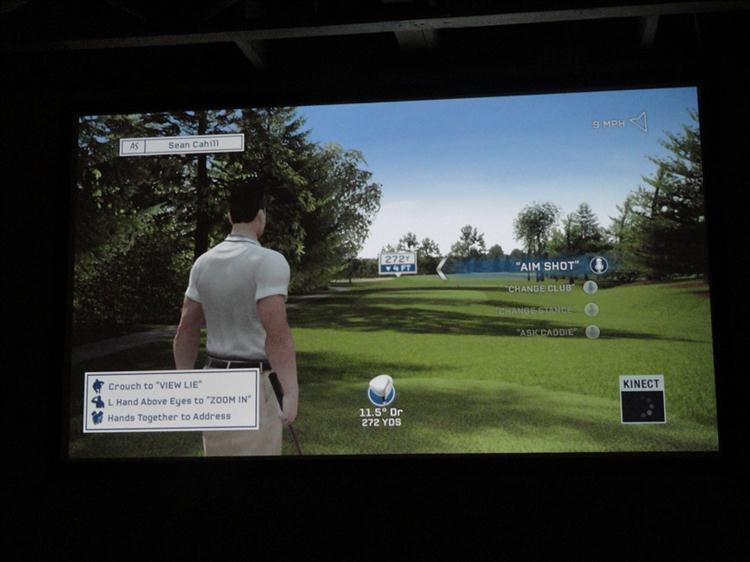
As I have done in the past, I went back and played a couple of the earlier titles form this generation of consoles that I had used as reference samples in previous projector reviews. I popped in Red Dead Redemption, Call of Duty: Modern Warfare 2 and Rock Band: The Beatles to see if the GT750E met or improved upon the performance of my previous test sessions. As I found when I did this same comparison with Optoma’s HD33, the GT750E definitely looks better with these older titles than I remember the initial projector review looking. That is an excellent sign for Optoma’s projectors, as their units continue to get better with each new model.
With more and more games coming out with 3D integrated, it is nice to have a projector capable of displaying it to whatever degree the developers put it into their game. The game I have been using as my reference sample is Super Stardust HD for the PlayStation 3. As mentioned in previous projector reviews, it absolutely pops off the screen in 3D. After spending some time with it while using the GT750E, I came away very impressed, even though the projo is native of 720p. The graphics were smooth, crisp and the 3D effect once again was leaping off the screen. For a game that is kind of basic in this generation of consoles, the developers of Super Stardust HD have done a remarkable job of showcasing the 3D effect. Something the Optoma GT750E was able to replicate flawlessly.
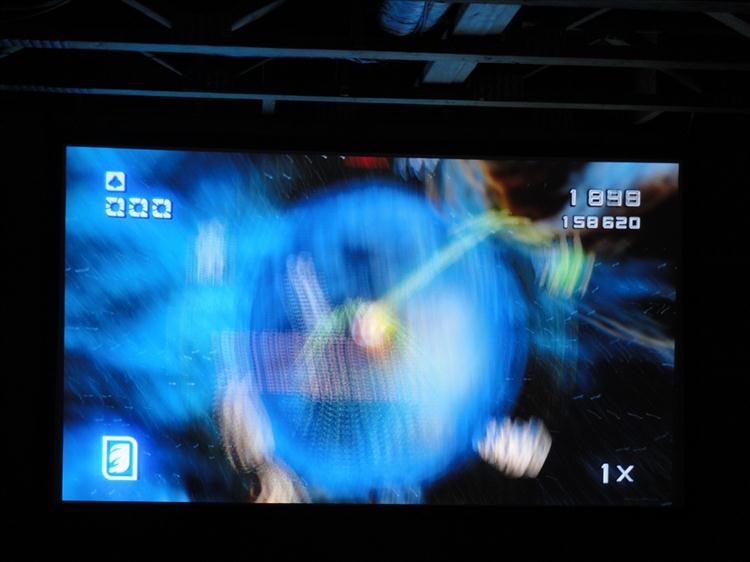
The second game I used for 3D testing was MLB 12 The Show. I was actually disappointed with the 3D effects from last years MLB 11 The Show, as it felt more like it was added as a last minute edition instead of being an integral part of the game. However, once I booted up MLB 12 The Show, it was a different story. After adjusting the 3D effect to the appropriate level, I was surprised at how much better it was with this year’s version of the game. The uniforms, ball, signage and players all had significantly more depth than last year. Even though the in-game objects did not jump off the screen like other 3D games, I believe the overall 3D effect for MLB 12 The Show provides a much more in-depth game play experience.
I went back and played a few additional 3D games and was equally impressed with the performance and visual effects that the GT750E produced. Much like last year’s HD33, the HD750E is impressive with 3D game play due to providing a complete 3D experience with image quality, performance and glasses technology.
Miscellaneous Items of Note
- Extremely Quiet Operation
- Short throw design
- Ships with RF transmitter only, glasses are separate cost
- Easy ceiling mount pattern
Testing Methodology
Items utilized in the testing of the Optoma GT750E included, but not limited to:
Testing was done at a throw distance of approximately six feet from a 92” 16:9 screen with a tabletop install location (~3.5 feet off the floor.) Seating was at a distance of 12 feet from the screen.
The Conclusion
The Optoma GT750E is an almost perfect blend of features and functionality for today’s gamer. Optoma was able to take their GT720 and their HD33 and create a projector that will meet or exceed what is expected for any game, let alone entertainment need. With a retail price right around the $799 mark, you cannot ask more for your money than the GT750E provides. The only thing that I could even mention that would be a so called complaint would be that it is not a full 1080p (it is native 720p) projector. However, when you consider the price tag, I certainly won’t be holding any grudges. If you haven’t already added a projector to your game room or man cave, this would be a very good option to consider.
Rating: 9.5 Excellent
* The product in this article was sent to us by the developer/company.

About Author
Like many gamers in their 40's, I developed my love of gaming from my Commodore 64 after we wore out our Intellivision. I spent countless hours wandering around the streets of Skara Brae, as my life was immersed in The Bard's Tale series on the C-64, D&D Titles and any/all Epyx titles (California Summer and Winter Games) and sports titles. After taking the early 90's off from gaming (college years) minus the occasional Bill Walsh College Football on Sega, I was re-introduced to PC games in the mid 1990's with a couple of little games called DOOM II and Diablo. I went all-in with the last generation of consoles, getting an Xbox 360 on launch weekend as well as adding a PS3 and Wii in subsequent years. I now am into the current-generation (latest?) of consoles with the WiiU and Xbox One. Recently, I was able to get back into PC gaming and have enjoyed it very much, spending most of my time going solo or playing with my fellow GamingNexus staffers in controlled multiplayer action.
While my byline is on many reviews, articles and countless news stories, I have a passion for and spent the last several years at GamingNexus focusing on audio & video and accessories as they relate to gaming. Having over 20 years of Home Theater consulting and sales under my belt, it is quite enjoyable to spend some of my time viewing gaming through the A/V perspective. While I haven't yet made it to one of the major gaming conventions (PAX or E3), I have represented GamingNexus at the Consumer Electronics Show (CES) in Las Vegas in nine of the last ten years.
Personally, I have been a staff member at GamingNexus since 2006 and am in my third tour of duty after taking off the last year and a half.










